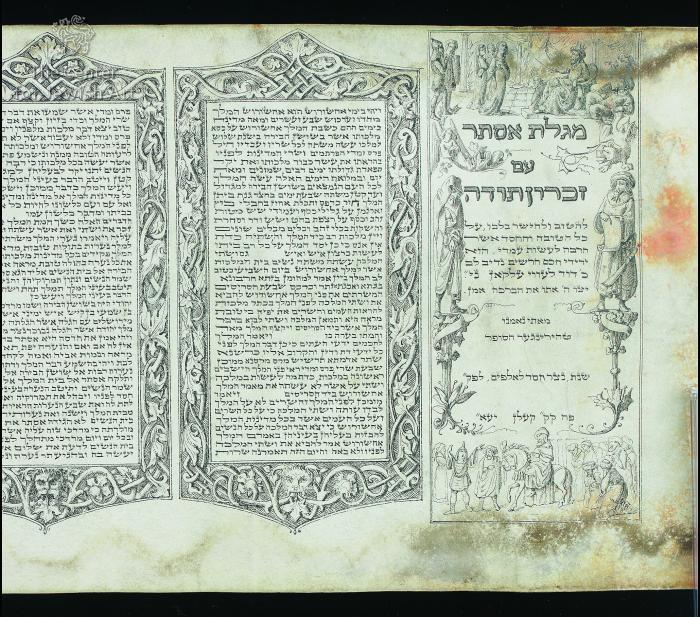Obj. ID: 37886
Jewish printed books JML David Levy Elkan and Thüringer Printed Esther Scroll, Cologne, 1843

The scroll opens with a rectangular panel decorated with two narrative scenes from the Book of Esther as well as two figures of men flanking the inscription in Hebrew bearing information about its origins. Columns of the text are rectangular and they are printed within the frames formed of dense foliate and floral ornaments with an interlaced pattern in their upper parts and masks in their lower parts.
The text was copied by Thüringer the Scribe and decorated by David Levy Elkan.
Another copy of this megillah is housed in The Library of the Jewish Theological Seminary (the scroll has been cut into 11 leaves and pasted into a book) and yet another copy was auctioned by Kestenbaum in 2015 (https://www.kestenbaum.net/auction/lot/auction-66/066-102/).
A short string is sewn to the right edge of the scroll.
sub-set tree:
Length of the sheets in the scroll: 1) 425 mm, 2) 430 mm.
Dimensions of the selected details in the scroll:
- text panel: 94x46 mm;
- decoration surrounding text panel 130x63 mm.
The scroll is preserved in good condition.
On the blank space at the beginning of the scroll, there is a large colorful stain. Also, the end of the scroll is yellower than the remaining part of it.
There are some moisture damages in the lower margins, at the beginning, and at the end of the scroll.
The Book of Esther in Hebrew preceded by an inscription in Hebrew.
The scroll is formed of 2 parchment sheets containing 11 text columns with 42 lines of printed text, except for col. 9 which has 11 lines printed in two half-columns.
The first sheet contains a prefatory panel and 5 columns of the text and the second sheet contains 6 columns.
The original text was written in the Hebrew Ashkenazi stam script with tagin.
The letters ח (Es. 1:6) and ת (Es. 9:29) are highlighted by their size. Other enlarged and diminished letters are included in col. 9.
The parchment is bright and rather stiff, both sides are almost identical, the blank side is very smooth.
The membranes in the scroll are stitched together.
In the prefatory panel of the scroll, some details regarding its production are included; the column is entitled in Hebrew: מגלת אסתר עם זכרון תודה - "Megilath Esther im Zichron Todah."
Another copy of the scroll featuring the same border is shortly described on https://www.kestenbaum.net/auction/lot/auction-66/066-102/ (accessed on 16.09.2020).
For other works of David Levy Elkan see https://www.bildindex.de/ete?action=displayResult/1 (accessed on 18.09.2020).
David Levy Elkan is listed among engravers in the Jewish Encyclopedia: http://www.jewishencyclopedia.com/articles/5768-engraving-and-engravers (accessed on 16.09.2020).
More literature is listed: https://de.wikipedia.org/wiki/David_Levy_Elkan (accessed on 16.09.2020).



